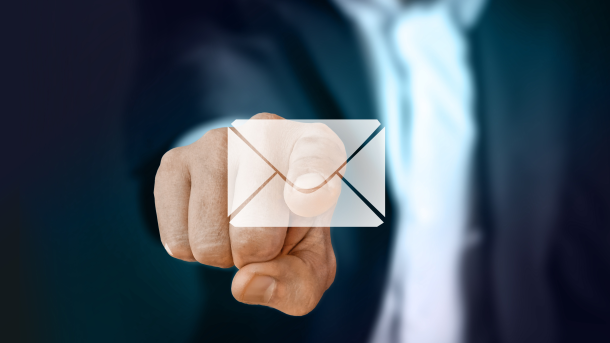Though ubiquitous across our professional and personal lives, the hard truth is that email is the number one vector for cyberattacks.
Every day, billions of cyber battles are fought in email inboxes around the world. That’s not an exaggeration, as our sources below reveal.
Email is by far the most vulnerable threat vector, and hackers have multiple ways to exploit it.
As banks look to protect their assets, their clients, and their reputation, email cybersecurity must become a top priority.
Today, we will explore the email threat landscape and provide five security countermeasures for your bank to consider.
The Email Cybersecurity Threat Landscape
While the following statistics are bleak, it’s vital to cover them in detail to better understand the dangers that banks face.
It’s important to remember that most cyberattacks are built to prey on human vulnerabilities. In the digital age, there’s nothing more human than the simple act of opening and sending emails. Cybercriminals know this, and they exploit it with extreme prejudice.
In 2020, a landmark study by Deloitte revealed that 91% of cyberattacks begin with an email. Despite increased awareness and training, the situation has not improved in recent years.
In fact, it has grown considerably worse. Global email cyberattacks surged 464% year-over-year in 2023, alongside a 24% increase in cyberattacks per company.
Hackers are getting more sophisticated, and their innovative methods are outpacing security defenses. For banks lacking sufficient countermeasures, it’s simply not a fair fight.
Indeed, while over 3.4 billion phishing emails are sent every single day, hackers only need one successful breach to do significant damage. And once they get in, they can quickly raid a bank’s data and extort its capital.
Of course, where phishing initiates an attack, malware delivers the kill-shot.
After users click a malicious link or download attachments, the cyber-threat officially moves from risk to reality. According to a Verizon report, 94% of malware is delivered by email.
Once installed, malware enables hackers to damage servers, disrupt operations, exfiltrate data, and ultimately, even demand payment (in what is known as ransomware).
The costs are devastating. In 2021, ransomware cost banks nearly $1.2 billion. As of this year, the average loss of a data breach across industries is $4.45 million (up 15% from 2020), while the losses for finance firms are 28% higher than the global average.
Beyond Phishing
These negative trends are exacerbated by an increasingly diversified hacking arsenal.
While phishing is the pervasive mode of attack, cybercriminals also leverage other social engineering techniques to breach networks.
With business email compromise (BEC), for example, attackers pose as trusted entities to trick employees into sharing sensitive information, sending money, or disclosing company information.
According to an FBI report, business email compromise cost U.S. victims $2.7 billion in 2022.
While BEC attacks are surging 81% year-over-year, an even more worrisome statistic has come to light: as reported by CyberRisk Alliance, from July to December 2022, 98% of employees failed to report suspicious emails.
In many cases, they mistook counterfeit emails for the real thing.
To perpetrate BEC attacks, bad actors spoof legitimate email domains. This tactic has fast become a primary threat for banking cybersecurity, and attackers don’t care how large, small, or successful the bank is.
For example, within days of the Silicon Valley Bank collapse, over 100 fake domains containing “SVB” were registered to dupe unsuspecting customers.
Ultimately, email cyberattacks depend on the art of deception.
While human beings remain the most vulnerable target, hackers can deceive networks and devices with equal cunning.
To face the future with confidence, banks must embrace the following security protocols to defend both their systems and the people that operate them.
Five Email Cybersecurity Measures to Consider
Email cybersecurity strengthens banks in several fundamental ways.
Above all, preventive measures reduce bank exposure across multiple endpoints. And even if breaches do occur, cybersecurity protocols expedite mean time to response (MTTR).
Data shows that firms with a cybersecurity infrastructure contained breaches 74 days faster—and saved $1.76 million more—than organizations lacking adequate cybersecurity deployment.
While a spectrum of strategies should be considered, these five email cybersecurity measures provide a powerful launchpad for your bank:
1. Employee Training
Knowledge alone won’t defeat cybercriminals, but it’s the best foundation on which to build.
What It Is
Employee training is an umbrella term that includes any educational program that promotes cybersecurity awareness, engagement, and proactivity among staff.
Cybersecurity training empowers staff to recognize the signs of an email attack, to report potential threats, and to avoid behavior that puts them (and their organization) at risk.
Why It’s Important
95% of data breaches involve human error, and emails are the most vulnerable vector in any organization.
Employees must be equipped with tools to limit their exposure and protect confidential data.
How to Implement
Many cybersecurity companies offer comprehensive training programs for businesses.
Consider some popular no-cost and subscription-based training solutions.
The Cybersecurity & Infrastructure Security Agency (CISA) also offers a free Incident Response Training curriculum.
However you choose to proceed, consider implementing regular security awareness training—and incident response (IR) testing—to help promote a culture of security among your staff.
If necessary, don’t hesitate to incentivize adherence to key email cybersecurity protocols.
The cost of cybersecurity protocols often pays significant dividends. In fact, employee training and incident response testing both rank in the top five of IBM’s cybersecurity cost-saving measures.
2. Multi-Factor Authentication (MFA)
Where education begins a process of preparedness, technology doubles the defense.
What It Is
Multi-factor authentication (MFA) is a security protocol that uses more than one authentication measure to verify a user’s identity.
Unlike outdated logins that require a single basic password, MFA requires multiple credentials to access a device, server, or database.
For example, an MFA protocol might ask a user to enter their password and then send a one-time code to their smartphone. Or, they may be asked for biometric authentication, like a fingerprint or facial scan.
Why It’s Important
Alphanumeric passwords are no longer enough. Today, cybercriminals use programs to rapidly guess username/password combinations and breach devices and servers.
These “brute force” attacks can execute millions of login attempts in a short period of time.
By leveraging multi-factor authentication, banks insulate themselves from common data breaches.
Even if a hacker correctly guesses an employee’s password, they won’t be able to access data without the user’s secondary credentials.
According to Anne Neuberger, Deputy National Security Advisor, MFA can prevent up to 90% of cyberattacks.
How to Implement
Given its success rate, MFA has become a staple of modern tech companies and the products they provide.
Whether you’re using an iPhone, Salesforce, Facebook, or Slack, you can easily turn on multi-factor authentication under your account settings/system preferences.
Regarding enterprise solutions, there are many MFA providers to consider.
3. AI and Machine Learning
Where human intelligence fails, artificial intelligence succeeds.
What It Is
Artificial intelligence (AI) is the technological emulation of human thought. An extension of AI, machine learning (ML) thrives on pattern recognition.
Together, these tools deliver powerful email cybersecurity solutions including anomaly detection and behavioral analysis, anti-spam email filtering, threat analysis, and more.
Why It’s Important
AI and ML cybersecurity solutions reduce the risk of human error.
In fact, studies show that they can identify malicious emails with 98% accuracy—detecting phishing, malware, and domain spoofing attacks along the way.
Though it’s essential to train employees, it’s equally important to acknowledge human limitations. After all, AI and ML can work 24/7 to protect your organization from bad actors.
How to Implement
AI and ML are well established in the world of cybersecurity. Check out seven of the best-reviewed AI email security solutions (and the plans they provide).
4. Data Loss Prevention (DLP)
Given the frequency of cyberattacks, countermeasures and containment protocols are a must.
What It Is
Data loss prevention (DLP) is a comprehensive security measure that prevents unauthorized sharing of confidential information.
Modern DLP platforms employ AI and ML techniques to enhance functionality.
While helping organizations meet compliance requirements (like PCI-DSS and GDPR), DLP solutions limit data exfiltration and destruction in the aftermath of a breach.
By analyzing endpoint devices and network traffic—whether in use, in transit, or in storage—DLP solutions can quickly identify and contain a data leak.
Why It’s Important
In addition to mitigating exposure to phishing attacks, DLP also plays an integral role in limiting insider threats.
Whether accidental or malicious, insider threats cost $15.38 million per incident.
By halting the unauthorized copying and forwarding of data, DLP blocks potential breaches while reducing collateral damage from active attacks. In the age of distributed teams, DLP is an essential protocol to defend the integrity of a remote workforce.
How to Implement
DLP platforms incorporate a range of tools across clouds, networks, emails, devices, and endpoints.
As such, considerable research will be necessary to determine the right fit for your organization. To help you get started, check out these ten popular DLP software solutions.
5. Email Authentication (DMARC, SPF, and DKIM)
Since cyberattacks thrive on spoofing, domain authenticity is more important than ever.
What It Is
DMARC, SPF, and DKIM are the three essential email authentication protocols. When unified, they provide dynamic protection against spam, phishing, and spoofing attacks.
Each protocol has unique attributes:
- DMARC (Domain-Based Message Authentication, Reporting and Conformance) stops phishing and BEC attacks by blocking delivery of fraudulent emails, increasing visibility into your email channel, and only authorizing delivery of emails from your trusted senders. With DMARC, your SPF and/or DKIM records can go to work protecting your email channel.
- SPF (Sender Policy Framework) identifies IP addresses of servers and senders you authorize to send emails from your domain (your trusted senders). Email platforms use SPF to verify whether an email server is a trusted sender for your domain. SPF alone is not enough, and requires DMARC to be effective.
- DKIM (DomainKeys Identified Mail) utilizes asymmetric cryptography (and adds a digital signature) to intercept email spoofing. DKIM is more specific than SPF, as it ensures an email has not been tampered with in transit, making it a stronger method of email authentication.
As cyberattacks proliferate, financial institutions are highly encouraged to incorporate all three authentication protocols as a best practice.
Why It’s Important
DMARC, SPF, and DKIM rank among the most effective tools to protect your domain. While fortifying your online presence (and defending your reputation), these standards deliver a solid defense against phishing and spoofing attacks.
By Q4 2022, financial institutions were the #1 target for global phishing attacks.
As social engineering schemes and BEC attacks continue to grow, email authentication protocols will become a mainstay of domain protection.
How to Implement
DMARC, SPF, and DKIM records are all stored within your domain name system (DNS) and are managed via your DNS provider.
To check how your domain is doing on email authentication, use this with this free tool.
The Role of Domain Security
While accelerating the financial world, online banking has become a hotbed of hacking and a target for the cybercriminal class.
As clients entrust your team with confidential information, hacking syndicates seek to exploit your business every hour of the day.
Amid a wide array of hacking techniques, a growing constituency of bad actors are leveraging spoofing attacks to hijack brands—and they’re doing it with impunity.
In fact, over 3.1 billion spoofed emails are sent every single day.
The importance of domain security and overall banking cybersecurity cannot be overstated. It’s time to take action to protect your good name with these email cybersecurity best practices.
When they’re used alongside a .Bank domain, your employees, vendors, and customers will be better protected from malicious emails and websites—the kinds that lead to breaches, identity theft, and significant financial loss.
Simply put, if it’s not .Bank, it’s not your bank.
Welcome to .Bank: Banking Fortified
In the shadow realm of cybercrime, banks need a comprehensive security protocol.
To fortify your company’s cybersecurity, you need strategies like multi-factor authentication (MFA), data loss prevention (DLP), machine learning tools, and a trained employee workforce.
There’s a step that you can take today to defend your financial institution (and it’s the easiest step of all): start with a trusted domain to protect your good name.
By moving your bank from an open, unrestricted domain to a .Bank domain, you’ll instantly add a vital layer of cybersecurity that stops hackers from undermining your business.
Founded on stringent security requirements, including DNSSEC with robust cryptographic algorithms, HTTPS protocol, and the enforcement of strong TLS, a .Bank domain acts as a fortress of trust in the digital banking landscape.
Factor in mandatory DMARC and SPF records for email communication (plus a rigorous verification and authentication process exclusive to banks and their associations), and you’ll gain a formidable shield against the schemes of even the most sophisticated cybercriminals.
With a .Bank domain name, you’ll never have to deal with counterfeit emails or lookalike websites abusing your company’s resources, logos, and reputation.
Find out why 800+ banks said goodbye to their old domains.



